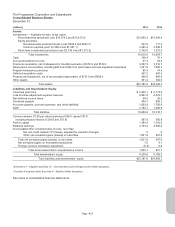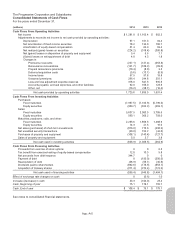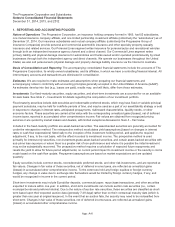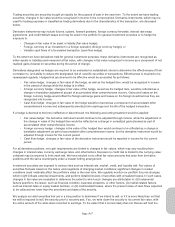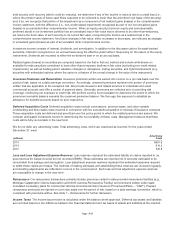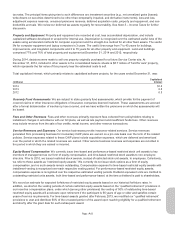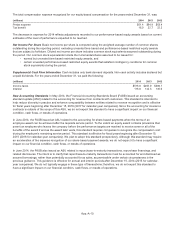Progressive 2014 Annual Report Download - page 9
Download and view the complete annual report
Please find page 9 of the 2014 Progressive annual report below. You can navigate through the pages in the report by either clicking on the pages listed below, or by using the keyword search tool below to find specific information within the annual report.
debt security until recovery (which could be maturity), we determine if any of the decline in value is due to a credit loss (i.e.,
where the present value of future cash flows expected to be collected is lower than the amortized cost basis of the security)
and, if so, we recognize that portion of the impairment as a component of net realized gains (losses) in the comprehensive
income statement, with the difference (i.e., non-credit related impairment) recognized as part of our net unrealized gains
(losses) in accumulated other comprehensive income. When an equity security (common equity and nonredeemable
preferred stock) in our investment portfolio has an unrealized loss in fair value that is deemed to be other-than-temporary,
we reduce the book value of such security to its current fair value, recognizing the decline as a realized loss in the
comprehensive income statement. Any future changes in fair value, either increases or decreases, are reflected as changes
in unrealized gains (losses) as part of accumulated other comprehensive income.
Investment income consists of interest, dividends, and amortization. In addition to the discussion above for asset-backed
securities, interest is recognized on an accrual basis using the effective yield method. Depending on the nature of the equity
instruments, dividends are recorded at either the ex-dividend date or on an accrual basis.
Realized gains (losses) on securities are computed based on the first-in first-out method and include write-downs on
available-for-sale securities considered to have other-than-temporary declines in fair value (excluding non-credit related
impairments), as well as holding period valuation changes on derivatives, trading securities, and hybrid instruments (e.g.,
securities with embedded options, where the option is a feature of the overall change in the value of the instrument).
Insurance Premiums and Receivables Insurance premiums written are earned into income on a pro rata basis over the
period of risk, based on a daily earnings convention. Accordingly, unearned premiums represent the portion of premiums
written that are applicable to the unexpired risk. We provide insurance and related services to individuals and small
commercial accounts and offer a variety of payment plans. Generally, premiums are collected prior to providing risk
coverage, minimizing our exposure to credit risk. We perform a policy level evaluation to determine the extent to which the
premiums receivable balance exceeds the unearned premiums balance. We then age this exposure to establish an
allowance for doubtful accounts based on prior experience.
Deferred Acquisition Costs Deferred acquisition costs include commissions, premium taxes, and other variable
underwriting and direct sales costs incurred in connection with the successful acquisition or renewal of insurance contracts.
These acquisition costs are deferred and amortized over the policy period in which the related premiums are earned. We
consider anticipated investment income in determining the recoverability of these costs. Management believes that these
costs will be fully recoverable in the near term.
We do not defer any advertising costs. Total advertising costs, which are expensed as incurred, for the years ended
December 31, were:
(millions)
Advertising
Costs
2014 $681.8
2013 619.3
2012 546.8
Loss and Loss Adjustment Expense Reserves Loss reserves represent the estimated liability on claims reported to us,
plus reserves for losses incurred but not recorded (IBNR). These estimates are reported net of amounts estimated to be
recoverable from salvage and subrogation. Loss adjustment expense reserves represent the estimated expenses required
to settle these claims and losses. The methods of making estimates and establishing these reserves are reviewed regularly,
and resulting adjustments are reflected in income in the current period. Such loss and loss adjustment expense reserves
are susceptible to change in the near term.
Reinsurance Our reinsurance transactions primarily include premiums ceded to state-provided reinsurance facilities (e.g.,
Michigan Catastrophic Claims Association and North Carolina Reinsurance Facility) and premiums written under state-
mandated involuntary plans for commercial vehicles (Commercial Auto Insurance Procedures/Plans – “CAIP”). Prepaid
reinsurance premiums are earned on a pro rata basis over the period of risk, based on a daily earnings convention, which is
consistent with premiums written. See Note 7 – Reinsurance for further discussion.
Income Taxes The income tax provision is calculated under the balance sheet approach. Deferred tax assets and liabilities
are recorded based on the difference between the financial statement and tax bases of assets and liabilities at the enacted
App.-A-8




